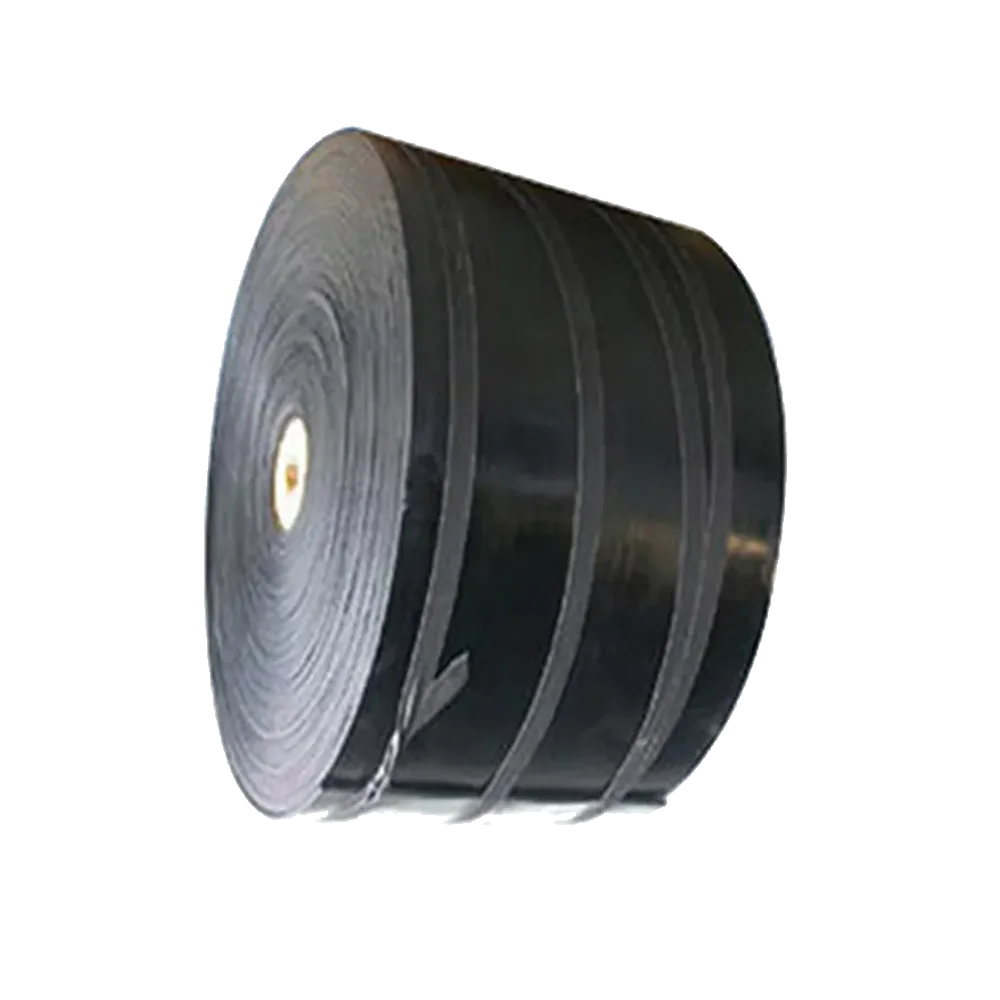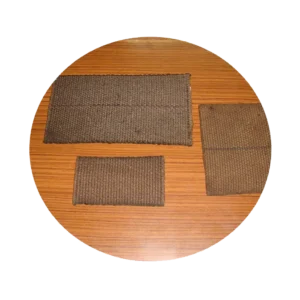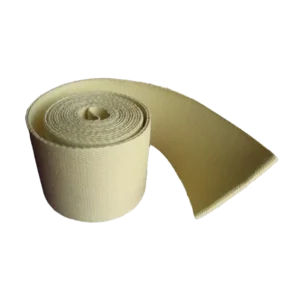Some of our Key personnel have more than 50 years of experience in the research and development, manufacturing and marketing of conveyor belts for bulk material handling with a specialization in underground mining operations. The company has a proven track record of Innovation in product design and application engineering with a deep commitment to customer service and safety.
It has the ability to significantly enhance the efficiency and productivity of bulk material handling operations while keeping safety as our number one priority. Given the severe conditions under which conveyor systems operate, it is important to select the right belt for each application. Conveyor Belts that are built to withstand the rigorous requirements for a variety of applications from General Purpose, High Heat, Fire Resistance, Moderate Oil Resistance, Abrasion Resistance, Hot Asphalt and Static Conductivity to meet International Guidelines and produce overall trouble free long service life. With our stringent quality control mechanisms and one of the best conveyor belting test facilities worldwide, we produce conveyor belt to meet your rigorous standards to provide the best quality.
Company – Why Us
- Quick response to requests for custom design and engineering enhancements to suit customer requirements.
- Proven expertise in texttile design and weaving technology.
- Proven expertise in Rubber compounding.
- Proven expertise in manufacturing process design and testing.
- Proven expertise in modifications to plant and equipment to meet new customer requirements.
- Reputation for on Time Delivery (OTD) to our extensive customer base throughout the world.
- Commitment to meeting the most stringent Quality standards.
- Company – Wide Commitment to meeting the highest standards of customer Service and Support.
Product
We offer a fully integrated product design and manufacturing process that offers our customers the following benefits:
- Complete in- house manufacturing process including yarn preparation, compounding, weaving, calendaring rubber to fabric and the ability to provide specific rubber covers, when required.
- A variety of woven fabric carcasses are designed to meet tensile strength requirements, operate efficiently and excellent fastener retention.
- Specific rubber compound covers provide optimum protection of the fabric carcass, while the fabric provides excellent longitudinal strength and transverse flexibility whether the conveyor system is empty or fully loaded.
- Ability to manufacture heavier covers on a variety of woven carcasses that offer longer wear, and more tonnage over the life of the belt.
- Molded edge belt design is available to protect belt edges and resists edge fraying.
- Excellent belt tracking on long center conveyors as well as multiple transfer points, both loading and unloading
- Each roll of belting is subjected to continuous in-process quality testing and must meet stringent final quality standards, both physical properties and MSHA Part 14 requirements.
- Each belt is Individually tested to pass the stringent standards set by MSHA.
- Products can be designed to conform to any country -Specific standards for use in underground mines as well as surface applications where there is a potential for fire.
- Products can be spliced by mechanical fasteners or by splicing using hot vulcanizing methods
- Excellent for a wide variety of applications by choosing the proper compound and fabric to match the operating conditions of the individual conveyor system.
Quality Assurance
Sharp attention focused on quality and continual in -process testing and controls are the basis of the excellent products that offer safe and efficient operation, Products undergo on-going quality checks in its well – equipped laboratories and shopfloors, from incoming raw materials to finished products.
- Incoming raw material- yarns and chemicals – are tested on arrival to verify the standards we established with our suppliers.
- Every finished roll is tested for conformity to physical property requirements established as our standard of excellence for every conveyor belt that is manufactured.
- Physical properties include width, thickness (belt & covers), tensile strength (Warp & weft), elongation (Warp & Weft), adhesion (cover to carcass and internal), fastener retention (static & dynamic ), cover abrasion resistance, troughability, etc.
- FRAS tests include flame (finger burn), flame propagation (Mid-Scale/B.E.L.T), drun friction and antistatic (static conductivity) as required by MSHA, CSA and others.
Fire Resistant Compounds
| Compound | Tensile Strength Min. (Mpa) | Tensile Strength Min. (Psi) | Elongation Min% | Application Grade |
|---|---|---|---|---|
| MSHA-14 | 15 | 2100 | 400 | MSHA 30CFR 14 (USA) |
| MSHA-18 | 16 | 2200 | 400 | MSHA 30CFR 18.65 (USA) |
| CAN-CSA-C | 16 | 2200 | 400 | CSA-C (Canada) |
| SCORF | 17 | 2400 | 400 | MSHA 30CFR 18.65 (USA) |
Product Range Summary
- Width-350mm to 2400mm (14″to 96″)
- Type-150KN/m to 3500KN/m(90PIW to 2000PIW)
- Covers-All Kinds of cover types.
- Special Covers-Available for abrasion, oil resistance, load impact
- Roll Length -Long Roll Lengths possible
- Color-Black, White, Tan and orange.
- Special Weave Constructions -Many Kinds of fabric constructions available.
Product Range Certifications
Product Approvals & Certifications:
India
- ISO 9001 : 2008 Certified.
- Directorate General of Mines Safety (DGMS) Approval As per IS 3181:1992.
- ISO 14001 Certified
- NABL Certified
United States of America
Mine Safety and Health Administration approval as per US-MSHA,Title 30 of code of Federal Regulations (CFR)
Canada
Canadian Standards Authority approval as per CSA-M422 Type C-1.
Chemical Compatibility Chart
This is a brief listing of our Chemical and Material compatibility list.
| Chemical | Natural Rubber, Isoprene (NR,IR) | Styrene, Butadiene (SBR,BR) | Butyl (IIR) | EPDM, EPM | Nitrile (NBR) | Neoprene (CR) | Hapalon (CSM) | Silicone (Sl,VMQ) | Viton, Flurorolastomer (FKM) |
|---|---|---|---|---|---|---|---|---|---|
| Ammonia Anhydrous | D | D | A | A | B | A | B | C | D |
| Ammonia Gas (cold) | A | A | A | A | A | A | A | A | D |
| Ammonia Gas (hot) | D | D | B | B | D | B | B | A | D |
| Ammonia Carbonate (Aqueous) | A | A | A | – | D | A | – | – | A |
| Ammonium Chloride (Aqueous) | A | A | A | – | D | A | – | – | A |
| Ammonium Chloride (Aqueous) | A | A | A | A | A | A | A | – | A |
| Ammonium Hydroxide | D | D | A | A | D | A | A | A | B |
| Ammonium Nitrate (Aqueous) | C | B | A | A | A | A | A | – | A |
| Ammonium Nitrite (Aqueous) | A | A | A | A | A | A | A | B | A |
| Ammonium Persulfate (Aqueous) | A | D | A | A | D | A | A | – | A |
| Ammonium Phosphate (Aqueous) | A | A | A | A | A | A | A | A | A |
| Ammonium Sulfate (Aqueous) | A | A | A | A | A | A | A | – | B |
| Amy/Acetate (Banana Oil) | D | D | C | C | D | D | D | D | D |
| Amy/Alcohol
Amy/Borate Amy/Chloronaptha |
B | B | A | A | B | B | A | D | B |
| D | D | D | D | A | A | A | – | A | |
| D | D | D | D | D | D | D | D | A | |
| Amy/Napthalene | D | D | A | A | D | D | C | D | C |
Advantages and Construction
Higher Adhesion Levels
The SFR belts have higher adhesion level compared to conventional belting available because of its special chemical bonding coupled with mechanical locking characteristics between cover to ply and ply to ply. These characteristics help to eliminate cover peeling & increase edge wear resistance, carcass consolidation and total elimination of ply separation.
Lower Self Weight and Higher Ply Strength
The use of synthetic filament provides higher ply strength than conventional belting and therefore, the SFR belts can meet high tension requirement using less number of plies. This construction feature of Phoenix SFR carcass has advantages like low drive power requirement and higher idler life.
High Resistance to Impact and Mechanical Damages
Higher adhesion levels improve belt consolidation, thereby providing high impact resistance and eliminating cover stripping/gouging.
Improved Troughing and Higher Capacity Utilisation
Higher transverse flexibility of the SFR belts as compared to conventional belts contribute to the users and conveyor designers the advantage like deep troughing of carcass, which increases volumetric transfer capacity and improves belt training at higher speed.
High Longitudinal Flexing Properties
The specially designed SFR belts with comparatively thin carcass renders effective longitudinal flexibility for negotiating over smaller pulleys and for reduction of flex fatigue strain on the belt.
Standard Belt Construction
A conventional rubber conveyor belt consists of cover rubber & carcass made up of skim coated reinforcing fabric.
Cover Rubber
It protects the carcass from external abrasion & impact injuries. The covers are also designed to resist adverse service conditions.
Different cover grades are available depending on the application:
Carcass
It provides the body to a belt. It is the tension & strength bearing member consisting of different textile materials namely Nylon and Polyester. The carcass is made of a number of plies bonded together with rubber compound specially designed to withstand rigors of application.
Polyester-Nylon (EP) fabric conveyor belt has the following advantages over Nylon-Nylon (NN) conveyor belt:
- General purpose
- Heat resistant
- Fire resistant
- Oil resistant
- Abrasion resistant
- Chemical resistant, etc.
Reference Elongation (%) Graph for EP and NN
- Low elongation
- Short take up
- Better moisture resistance
- Low creep because of higher modulus
Edge Construction
The SFR belts are supplied in moulded edge/cut edge constructions. Synthetic fabric is rot and mildew resistant and therefore making it possible to manufacture belts in any edge construction as per requirement.
Rubber Skim Coat
A thin film of rubber layer placed in between the plies enhances the anchorage of rubber to fabric to facilitate the flex life augmented by elasticity. It further protects the carcass from impact damage & moisture ingress.
Breaker Fabric
Breaker fabric is recommended for critical application. It is placed between the cover and the carcass to improve additional anchorage through locking and to resist cover against gouging, stripping and tearing. It finds particular application where impact due to fall of lumps from greater height is experienced.
Cover Rubber
Standards Applicable
Conveyor belts manufactured by us conforms to IS : 1891 (Parts-I, II, III, V) and also to BS 490 (Part-I) DIN, Canadian Bureau of Mines, AS, JIS, MSHA, SANS and various other international specifications.
Range of Products
Width
Conveyor belts are offered in widths from 550 mm to 2400 mm. For lower width, i.e. 300 mm to 550 mm, we provide belts in equal length with cut-edge construction.
Tensile Strength & Type
Conveyor belts are manufactured in two types viz. heavy duty and extra heavy duty and such types are selected on the basis of various operating conditions like load support characteristics, impact, troughing angle, belt fatigue, etc. We are in a position to manufacture SFR conveyor belting of tensile strength up to 3000 kN/m and up to 9 ply construction (however, the standard range of belting upto tensile strength of 2500 kN/m is indicated in the belt selection tables).
Cover
Grades M-24 & N-17 are manufactured for general purpose belting conforming to abrasion loss characteristics as per IS-1891 when tested in line with DIN 53516.
Grades IS T1, IS T2, ultra heat resistant both are manufactured for various typical heat resistant applications.
THE SFR belts with fire resistant (FR) grade of rubber covers are manufactured suitable for use in open cast, underground mines, thermal power stations, especially
where fire hazards exists. Special grades like oil resistant, superior abrasion resistant, chemical resistant, energy optimised belts (EOB) are also within standard range of products.
Cover Element : CoverRubber
Minimum Pulley Diameters (to DIN 22101)
The pulley diameters in a belt conveyor system depend on the design, on strains and on the type of splice of the conveyor belt.
The minimum pulley diameter (DTr min) Gr A for group A pulleys can be roughly determined by utilizing the thickness value of the tensile member in the belt i.e. dGK as follows:
A pulley diameter so obtained shall be rounded up to the next higher standard pulley diameter (see tables below).
| (Dtr min )Gr A = (Material Characteristic Calue) (dGK) | |
|---|---|
| Tensile Member Material in Belt Longitudinal Direction | Material Characteristics Value |
| E (Polyester) | P (Polyamide) |
| 108 | 90 |
A pulley diameter so obtained shall be rounded up to the next higher standard pulley diameter (see tables below).
Testing
Our laboratory is equipped with the most modern testing facilities to meet excellence in product quality and international standards right from raw material to finished product. Some of the important facilities include:
Rheometer
Rheological behaviour of 100 per cent batch of rubber mix is studied prior to release for production. Cure rate index, plasticity and optimum cure time are determined by this machine.
Universal Testing Machine
Equipped with printer 10T tester is used for determination of tensile strength and elongation.
Drum Friction Testing Machine
Drum friction test rig attached with different gadgets is used to determine the fire resistance behaviour of conveyor belt.
Abrasion Testing Machine
Resistance to abrasion behaviour is determined by this machine.
Electrical Resistivity Tester
The antistatic property is determined by ring electrodes.
Multi Cell Ageing Oven With Microprocessor Based Temperature Controller
It is used to determine the ageing characteristics of finished products.
Service and Maintenance
Service
We Offer You:-
- The very latest international technology, indigenously available at your doorstep.
- The benefit of a constant update on improvement of technology in bulk handling.
- The highest level of quality with the consistency and reliability, true to the spirit of ISO 9001 and ISO 14001 certification.
- The solution to your material handling needs at the concept stage itself.
- A dedicated design for every conveyor project to ensure ultimate cost-benefit of your investment.
- The services of international class towards optimum design and selection of belts, maintainability of belts, solution of conveyor problems, modernization of conveyors.
- The services for conveyor belt laying, splicing and commissioning.
Maintenance
The following suggestions are offered to derive the best services of a textile conveyor belt:
- Loading at the centre of the belt.
- Cleaning of belt by scrapers.
- Installing training idlers on carrying and return run to avoid belt-hits on the structure.
- Early repair of cover damages.
- Using skirt board with special rubber and not from old belt.
- Maintaining an edge clearance of 75 mm for belt edge from structure.
- Maintaining correct transition distance.
For details on splicing, troubles and corrective actions, please refer to our operation and maintenance (O&M) manual.
Fabric Weaving and Dipping Plant
We have our own fabric weaving and RFL Dipping plant to ensure that the material for the carcass is available at the shortest possible time. It is evident that the customer gets a top quality synthetic fabric reinforced conveyor belt with a much reduced delivery period than is otherwise available from other sources and at a very competitive price.
We weave from twisted yarns of the highest quality NN and EP fabric of width upto 1600 mm and weight upto approximately 1500 grammes per square metre and strength upto 450 KN/Metre. The Yarn tension control device ensures that bagginess of the fabric is eliminated. The looms are most modern and precise and are automated.
The Woven fabric is subjected to stringent tests before being transferred to the conveyor belt manufacturing unit.




